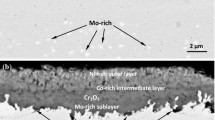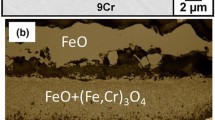Abstract
Helium used as a coolant in high-temperature gas-cooled reactors contains gaseous impurities that cause various corrosion effects. To determine the mechanisms of the reactions that occur in this complex gas phase, a theoretical and experimental characterization of the gas is given in part 1. To obtain estimates of the reactions that are possible in principle and to derive the basis for the interpretation of the experimental results, thermodynamic considerations on gas equilibrium and partial equilibria are presented. Because of the extremely low concentrations of the impurities, diffusion processes within the gas may become rate-controlling. This requires a consideration of the flow conditions. The reactions of Pt, Cr, Cr2O3 and Cr3C2 with helium-based atmospheres containing impurities are investigated by means of a mass spectrometric gas analysis with respect to temperature and flow rate. A set of six reactions is derived from the results and discussed in detail. The application of these equations to describe the high-temperature corrosion phenomena of a technical nickel-base alloy is dealt with in part 2.
Similar content being viewed by others
References
H. Nickel, T. Kondo, and P. L. Rittenhouse,Nucl. Technol. 66, 12 (1984).
H. Nickel,Chem. Ing. Technol. 49, 639 (1977).
H. Schuster, R. Bauer, and L. Graham,Proceedings of the Eighth International Congress on Metallic Corrosion (DECHEMA, Frankfurt, 1981), p. 1601.
F. N. Mazandarany and P. L. Rittenhouse,Nucl. Technol. 29, 406 (1976).
W. J. Quadakkers and H. Schuster,Werkst. Korr. 36, 141 (1985).
W. J. Quadakkers and H. Schuster,Nucl. Technol. 66, 383 (1984).
L. W. Graham and K. G. E. Brenner,Proceedings of the Eighth International Congress on Metallic Corrosion (DECHEMA, Frankfurt, 1981), p. 1607.
H. J. Christ, D. Schwanke, Th. Uihlein, and H. G. Sockel,J. Phys. E 19, 793 (1986).
R. H. Kane and P. D. Goodell,J. Testing Eval. 10, 286 (1982).
C. S. Giggins and F. S. Pettit,Oxid. Met. 14, 363 (1980).
I. Barin and O. Knacke,Thermochemical Properties of Inorganic Substances (Springer-Verlag, Berlin, 1977).
S. R. Brinkley,J. Chem. Phys. 14, 583 (1946).
W. B. White, S. M. Johnson, and G. B. Danzig,J. Chem. Phys. 28, 751 (1958).
F. J. Zeleznik and S. Gordon,Indus. Eng. Chem. 60, 27 (1968).
R. H. Kane,Corrosion NACE 36, 112 (1980).
J. P. Pfeifer, Technische Notiz IRW-TN-123/82, KFA Jülich (Jülich, 1982).
I. F. Globubev,Viscosity of Gases and Gas Mixtures (Bindery, Jerusalem, 1970).
H. Brauer,Stoffaustausch (Sauerländer, Aarau, Frankfurt, 1971).
J. O. Hirschfelder, C. F. Curtis, and R. B. Bird,Molecular Theory of Gases and Liquids (Wiley, New York, 1954).
H. J. Christ and H. G. Sockel,High Temp. Technol. 5, 123 (1987).
H. J. Grabke, K. J. Best, and A. Gala,Werkst. Korr. 21, 911 (1970).
H. J. Grabke,Ber. Bunsenges. 69, 48 (1965).
H. J. Grabke,Ber. Bunsenges. 71, 1067 (1967).
J. P. Pfeifer, Technische Notiz IRW-TN-46/82, KFA Jülich (Jülich, 1982).
P. Münster and H. J. Grabke,Arch. Eisenhüttenwes. 51, 319 (1980).
H. J. Grabke,Ber. Bunsenges. 69, 409 (1965).
H. J. Grabke,Met. Trans,1, 2972 (1970).
H. J. Grabke, E. M. Müller, and G. Konzos,Scripta Met. 14, 159 (1980).
H. J. Grabke and G. Tauber,Arch. Eisenhüttenwes. 46, 215 (1975).
S. R. Shatgnski and H. J. Grabke,Arch. Eisenhüttenwes. 49, 129 (1978).
D. S. Williams, R. Möller, and H. J. Grabke,High. Temp. Sci. 14, 33 (1981).
Author information
Authors and Affiliations
Rights and permissions
About this article
Cite this article
Christ, H.J., Schwanke, D., Uihlein, T. et al. Mechanisms of high-temperature corrosion in helium containing small amounts of impurities. I. Theoretical and experimental characterization of the gas phase. Oxid Met 30, 1–26 (1988). https://doi.org/10.1007/BF00656642
Received:
Revised:
Issue Date:
DOI: https://doi.org/10.1007/BF00656642




